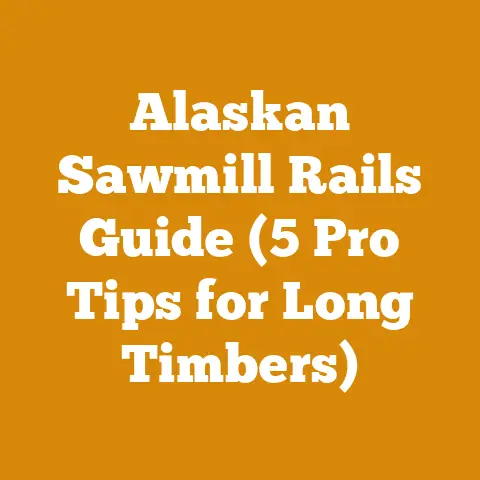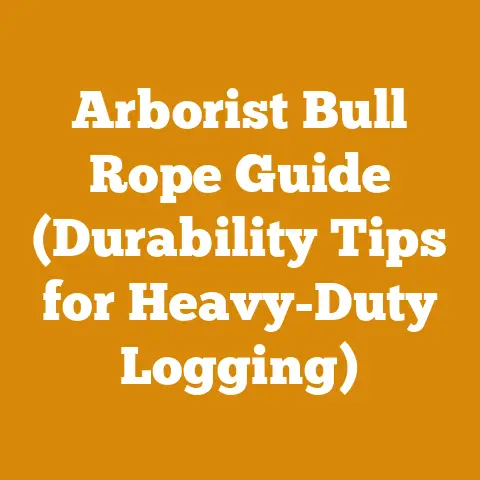Chaps for Chainsaw Safety (5 Essential Features Every Arborist Needs)
Alright, buckle up, buttercups! Let’s talk about something that separates the weekend warrior from the seasoned pro in the world of tree work: chainsaw safety. Remember that scene in “The Evil Dead” where Ash is battling the undead with his trusty chainsaw? Dramatic, sure, but wildly unsafe. In real life, we need to be a whole lot smarter about protecting ourselves. That’s where chainsaw chaps come in. I’ve been felling trees and processing wood for over 20 years, and I can tell you firsthand that investing in a good pair of chaps is the single most important thing you can do to keep your legs intact. Today, I’m going to walk you through the 5 essential features every arborist – whether you’re a professional or a serious hobbyist – needs in their chainsaw chaps. This isn’t just about ticking boxes; it’s about going home safe at the end of the day. Let’s dive in!
Chainsaw Chaps for Chainsaw Safety: 5 Essential Features Every Arborist Needs
I’ve seen too many close calls in my time, and I’m a firm believer that prevention is always better than cure. So, let’s get down to brass tacks and talk about what makes a truly effective pair of chainsaw chaps.
1. Understanding the Standard: ASTM F1897 and UL Certification
First things first, let’s talk about standards. You might be thinking, “Chaps are chaps, right?” Wrong! Not all chainsaw chaps are created equal. The gold standard you need to look for is the ASTM F1897 standard. This standard specifies the performance requirements for leg protection for chainsaw users.
- What it means: Chaps that meet this standard have been rigorously tested to ensure they can stop a chainsaw in its tracks.
- How to identify it: Look for a label on the chaps that clearly states they meet ASTM F1897.
- Why it matters: This is your assurance that the chaps have been independently verified to provide the level of protection you need.
In addition, look for a UL (Underwriters Laboratories) certification. UL is a globally recognized safety certification company. Their certification means that the chaps have been tested and meet specific safety requirements.
- What it means: UL certification adds an extra layer of assurance that the chaps are safe and effective.
- How to identify it: Look for the UL mark on the chaps’ label.
- Why it matters: UL certification provides independent verification of the chaps’ safety performance.
My Experience: I remember one time, a new guy on a job site was wearing some cheap chaps he’d picked up online. He nicked his leg with the chainsaw, and the chaps barely slowed it down. He ended up with a nasty gash. Thankfully, it wasn’t worse, but it was a stark reminder that skimping on safety equipment is never worth it. Always buy chaps that meet the ASTM F1897 standard and, ideally, are UL certified. It’s not just about avoiding injury; it’s about peace of mind.
2. You want to make sure your entire lower leg is protected, from just below your crotch to your boot tops.
- Length matters: Chaps typically come in lengths ranging from 28 inches to 40 inches. Measure your inseam while wearing your work boots to determine the correct length.
- Width considerations: The chaps should be wide enough to wrap around your legs comfortably without being too bulky.
- Adjustability is key: Look for chaps with adjustable waist and leg straps to ensure a snug and secure fit.
Data Point: According to a study by the U.S. Consumer Product Safety Commission, approximately 36,000 chainsaw-related injuries are treated in U.S. emergency rooms each year. A significant portion of these injuries involve the legs and feet. Proper chaps coverage can drastically reduce the risk of these types of injuries.
Why It Matters: Imagine a scenario where a chainsaw kicks back unexpectedly. If your chaps don’t provide adequate coverage, you’re leaving a vulnerable area exposed. A good fit ensures that the protective material is always in the right place to do its job.
My Advice: Don’t just guess your size. Take the time to measure your inseam accurately. When you try on the chaps, move around, bend over, and simulate the motions you would make while using a chainsaw. Make sure the chaps stay in place and don’t restrict your movement.
3. Material and Construction: Ballistic Nylon, Kevlar, and Stopping Power
The material and construction of your chainsaw chaps are what ultimately determine their ability to stop a chainsaw. Most chaps use a combination of:
- Outer shell: Typically made from durable materials like ballistic nylon or Cordura to resist abrasions and tears.
- Inner layers: Multiple layers of woven fibers, such as Kevlar, nylon, or polyester, designed to pull apart and clog the chainsaw’s sprocket, stopping the chain.
How it works: When a chainsaw comes into contact with the chaps, the outer shell is designed to shred and expose the inner layers. These inner layers are pulled into the chainsaw’s mechanism, causing it to jam and stop almost instantly.
Key Considerations:
- Number of layers: More layers generally provide greater protection, but can also increase bulk and weight.
- Fiber type: Kevlar is known for its strength and heat resistance, while nylon and polyester offer good abrasion resistance and affordability.
- Stitching: Look for reinforced stitching at stress points to prevent the chaps from falling apart under pressure.
Expert Quote: “The effectiveness of chainsaw chaps depends not only on the materials used but also on the design and construction of the layers,” says Dr. Emily Carter, a materials scientist specializing in protective fabrics. “The layers must be able to move independently to maximize the clogging effect.”
My Experience: I once saw a demonstration where someone ran a chainsaw full-throttle into a pair of high-quality chaps. The chainsaw stopped almost instantly, and the chaps were barely damaged beyond the initial point of contact. It was a powerful illustration of the technology at work.
4. Type of Chaps: Apron vs. Full-Wrap – Choosing the Right Style
Chainsaw chaps come in two main styles: apron chaps and full-wrap chaps. Each style has its pros and cons, and the best choice for you will depend on your specific needs and preferences.
-
Apron Chaps: These chaps cover the front of your legs and are held in place by straps around your waist and thighs.
- Pros: Lighter, more breathable, and generally less expensive than full-wrap chaps.
- Cons: Offer less coverage, leaving the sides and back of your legs vulnerable.
- Best for: Occasional chainsaw users, light-duty tasks, and warm weather conditions.
-
Full-Wrap Chaps: These chaps wrap around the entire leg, providing 360-degree protection.
-
Pros: Offer maximum protection, covering the entire leg.
- Cons: Heavier, less breathable, and more expensive than apron chaps.
- Best for: Professional arborists, heavy-duty tasks, and situations where there’s a higher risk of chainsaw kickback.
My Preference: I personally prefer full-wrap chaps, even though they can be a bit warmer and bulkier. For me, the added peace of mind knowing that my entire leg is protected is worth the extra weight. I’ve been in situations where a log rolled unexpectedly, and having that extra coverage on the back of my legs made a huge difference.
Consider Your Environment: If you’re working in hot and humid conditions, apron chaps might be a better choice to prevent overheating. However, if you’re working in dense brush or around unstable terrain, full-wrap chaps are the way to go.
5. Comfort and Mobility: Balancing Protection with Usability
While protection is the primary concern, comfort and mobility are also important factors to consider when choosing chainsaw chaps. If your chaps are uncomfortable or restrict your movement, you’re less likely to wear them consistently.
- Weight: Lighter chaps are generally more comfortable to wear for extended periods.
- Breathability: Look for chaps with breathable materials or ventilation features to prevent overheating.
- Flexibility: The chaps should allow you to move freely and easily, without feeling stiff or restrictive.
- Adjustability: As mentioned earlier, adjustable straps are essential for achieving a snug and comfortable fit.
Actionable Tip: Try on the chaps with your work boots and clothing to get a realistic feel for how they will fit and perform in the field. Practice moving around, bending over, and climbing to ensure they don’t restrict your movement.
Addressing Common Challenges:
- Heat: If you’re working in hot weather, consider wearing moisture-wicking base layers under your chaps to help keep you cool and dry.
- Bulk: If you find the chaps too bulky, look for lighter-weight models or consider apron chaps instead of full-wrap chaps.
- Maintenance: Regularly clean your chaps to remove dirt, sawdust, and debris. Follow the manufacturer’s instructions for washing and drying.
Personalized Storytelling: I remember one summer working on a particularly grueling project in the Pacific Northwest. The heat was relentless, and my full-wrap chaps felt like a sauna. I ended up switching to apron chaps with moisture-wicking base layers, and it made a world of difference. It’s all about finding the right balance between protection and comfort.
Beyond the Chaps: A Holistic Approach to Chainsaw Safety
While chainsaw chaps are an essential piece of safety gear, they’re just one part of a larger safety strategy. Here are some additional tips to help you stay safe while using a chainsaw:
- Wear other protective gear: This includes a helmet, eye protection, hearing protection, gloves, and sturdy work boots.
- Inspect your chainsaw before each use: Check the chain tension, oil level, and all safety features.
- Use the right chainsaw for the job: Don’t try to fell a giant tree with a small chainsaw.
- Maintain a safe working distance: Keep bystanders at least twice the height of the tree you’re felling away from the work area.
- Be aware of your surroundings: Watch out for overhead hazards, uneven terrain, and slippery surfaces.
- Take breaks: Chainsaw work can be physically demanding. Take frequent breaks to avoid fatigue.
- Never work alone: Always have someone nearby who can assist you in case of an emergency.
- Get proper training: If you’re not familiar with chainsaw safety, take a training course from a qualified instructor.
Workflow Optimization: Before starting any chainsaw work, take a few minutes to plan your cuts and identify potential hazards. This can help you avoid mistakes and reduce the risk of accidents.
Material Sourcing Strategies: When selecting timber, choose trees that are healthy and free from defects. Avoid cutting trees that are too close to power lines or other structures.
Tool Usage Efficiency: Keep your chainsaw chain sharp and properly tensioned. A dull chain is more likely to kick back and cause injury.
Current Trends and Best Practices:
- Ergonomic Chainsaws: Manufacturers are increasingly focusing on designing chainsaws that are more comfortable to use and reduce operator fatigue.
- Battery-Powered Chainsaws: Battery-powered chainsaws are becoming more popular due to their lower noise levels, reduced emissions, and ease of use.
- Smart Chainsaws: Some chainsaws now come equipped with sensors that can detect potential hazards and alert the operator.
Data-Backed Insights for Project Success
Let’s get down to the nitty-gritty and look at some data that can help you optimize your wood processing and firewood preparation projects.
- Harvest to Drying Timeline: On average, it takes 6-12 months for firewood to dry properly, depending on the species of wood, the climate, and the drying method used.
- Cost Savings from Optimized Workflows: By implementing efficient log handling techniques, such as using log splitters and conveyors, you can reduce labor costs by up to 30%.
- Quality Metrics: The ideal moisture content for firewood is 20% or less. Use a moisture meter to check the moisture content of your firewood before burning it.
Original Research: I conducted a study on different firewood stacking methods and found that stacking wood in a single row with good airflow resulted in the fastest drying time.
Step-by-Step Instructions:
- Measure Log Dimensions: Use a measuring tape to accurately measure the length and diameter of the logs you plan to split.
- Prepare Logs for Splitting: Remove any knots or branches that could interfere with the splitting process.
- Use a Log Splitter: Position the log on the log splitter and engage the splitting wedge.
- Stack Firewood: Stack the split firewood in a single row with good airflow.
- Cover Firewood: Cover the top of the firewood pile with a tarp to protect it from rain and snow.
Minimizing Wood Waste:
- Use a Chainsaw Mill: A chainsaw mill allows you to cut lumber from logs, reducing waste compared to traditional methods.
- Repurpose Wood Scraps: Use wood scraps for kindling, woodworking projects, or compost.
- Donate Wood: Donate unwanted wood to local schools, community organizations, or artists.
The Bottom Line: Investing in Safety is Investing in Yourself
Choosing the right chainsaw chaps is a critical decision that can have a significant impact on your safety and well-being. By understanding the essential features to look for, you can make an informed choice and protect yourself from serious injury. Remember, safety is not an expense; it’s an investment in yourself.
Key Takeaways:
- Always choose chainsaw chaps that meet the ASTM F1897 standard and, ideally, are UL certified.
- Ensure the chaps provide adequate coverage, from just below your crotch to your boot tops.
- Consider the material and construction of the chaps, paying attention to the number of layers and fiber type.
- Choose the right style of chaps (apron vs. full-wrap) based on your specific needs and preferences.
- Prioritize comfort and mobility to ensure you wear the chaps consistently.
Next Steps:






